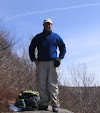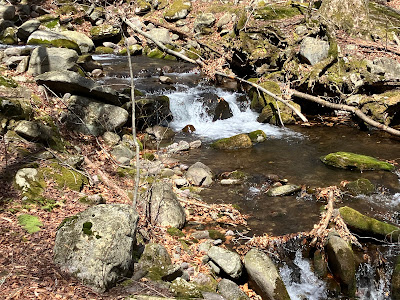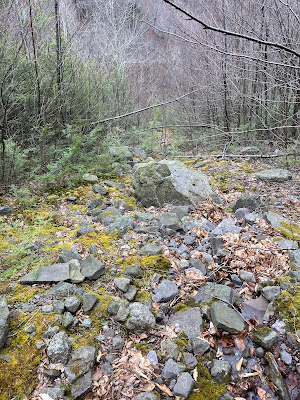Landslides, also known as debris avalanches, are not a common occurrence in New York’s Catskill Mountains. Only a handful of slides are visible on Catskill slopes today. In his landmark study, The Catskill Forest, A History, Dr. Michael Kudish notes that landslides in the Catskills typically originate when an overhanging sandstone ledge gives way under the weight of water saturation. Slides in the Catskills are most common along the very steep slopes of the eastern front of the mountains, known as the Escarpment.
One of the best-known Catskill slides fell on the NE slope of Friday Mountain on May 29, 1968. After a heavy rainfall, an overhanging sandstone ledge collapsed at an elevation of 3,100 ft., triggering a slide that swept down to 1,970 ft. Though this slide is mostly revegetated with small trees, one significant open area remains on its lower half. The slide is occasionally used as part of a very steep and rugged bushwhack ascent of Friday Mountain (3,694 ft.). The 1971 edition of the New York Walk Book noted that both a 1930 slide on Cornell Mountain and the 1968 Friday slide “may be attractive to the venturesome.”
As a slide enthusiast in the White Mountains and a fan of the Catskills, naturally I had to pay a visit to the Friday Mountain slide. On a cold and very windy day with partial sun, Carol dropped me off at the remote trailhead at the end of Moonhaw Road (great name!) and headed off for a day of geocaching.

To head into the valley that leads to the slide, it was necessary to ascend partway up the herd path to Friday Mountain to skirt a parcel of private land. That path starts with a stiff ascent on a woods road.
The first of many hardwood blowdowns encountered during the day.
Looking up at a spur of Wittenberg Mountain informally known as Blackberry Ridge. It has a long band of open ledges, a potential destination for a future bushwhack.
A view of Wittenberg at the head of the valley of the north fork of Wittenberg Brook.
A deceptively gentle stretch of the Friday herd path. This is one of the more difficult of the Catskill 3500 peaks with an ascent of 2600 ft., including some very steep, cliffy terrain in the upper reaches.
Once beyond the private land, I made a steep descent to the south branch of Wittenberg Brook.
For the next mile of bushwhacking, the brook scenery was continuous and gorgeous.
Looking back.
One of the easier sections along the brook.
One of many small cascades.
Where the ravine closed in, it was slow going along the edge of the brook or the adjacent sidehill.
A beautiful stretch of open woods on a gentle slope above the brook.
Descending to cross the brook to avoid a steep sidehill. Up to this point I had stayed on the south side of the ravine.
I scrambled up to an old logging or bark road on the north side of the brook.
Before long this road led me back across to the south side.
What a beautiful valley in the Slide Mountain Wilderness.
Following the remnants of the road towards the steep headwall of the valley, formed by Cornell Mountain, a hump nicknamed "Dink," and Friday Mountain.
Getting closer.
Approaching the point at ~2000 ft. where the brook forks, the left fork leading to the slide. It had taken quite a while to reach this point due to shifting terrain and rocky footing disguised by a deep carpet of leaves.
There's the lower track of the slide!
Lots of loose rock - careful attention to footing required. The vegetated areas sport a dense growth of small yellow birch, hemlock and other trees.
Tumbling cascades on the fork of the brook that parallels the slide.
Jumbled rocks of all sizes.
Following one of several sub-tracks of the slide. Before revegetation began, this was quite a large slide.
A typical debris flow levee deposited along the edge of this track.
Approaching the open part of the slide at ~2200-2300 ft.
Almost there.
Nearly 57 years after it fell, this is the only significant open area remaining on the slide.
Looking down.
From the east side of the slide, a fine view up to 3870-ft. Cornell Mountain.
Looking out to eastern spur ridges of Cornell and Wittenberg, with Samuels Point peering over in back.
It was cold and windy up here, but I was able to bundle up and hang out for a while.
The top of the open part of the slide. Above here the slide is almost completely revegetated, except for two small open patches at 2600 ft. and 2700 ft.
A wider view of Cornell.
Side view of the slide, moderately steep here at 28-29 degrees.
There is a vigorous growth of small hemlocks and aspens along the edge of the open slide. I did not see a single white pine on the section of the slide that I traversed. I have found at least one white pine on about 70% of the 80+ White Mountain slides I have visited.
Heading down, slowly and carefully on the loose footing.
Severe gouging evident on the edge of the slide.
Down we go.
A different track of the slide than the one I ascended.
Looking back at the very bottom of the slide.
Farewell to the upper valley, a wild and remote place.
The wind continued to gust. If you look closely, you can see leaves being blown across in the top center of the photo.
Enjoying the brook scenery again on the way down.
I followed the old road on the north side for a longer distance, but it eventually petered out.
Back to slowly working my way along the brook.
At times I would posthole into piles of leaves - good reason to proceed slowly.
Climbing back up the slope to skirt the private land near the trailhead.
Back on the Friday Mountain herd path, concluding a most interesting day in the Catskill wilds.



















































No comments:
Post a Comment